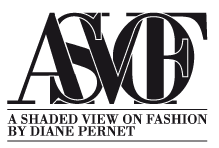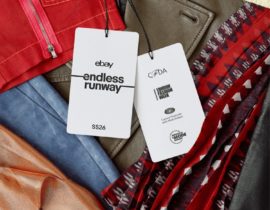If embroidery fills you with visions of grandma’s kitchen table or kitsch knick-knacks scattered across the homes of the less fashion-forward set, then it’s time to recognise what it means to appreciate the creation of a truly beautiful art form.
Recently, there has been strong trend of embroidery on the runways, with leaders like Balmain, Dolce & Gabbana and Alexander McQueen showcasing an artisanal look which we are going to be seeing a lot more of. While there are florals and landscapes hand sewn onto dresses, skirts and tops, on closer inspection you will see that it´s not all softness and light. Some of today’s collections feature strong, abstract designs that are perfect for a bespoke rock ´n´ roll vibe.
One such atelier which is literally raising the profile of fabric is the Jato S.p.A (Group). Formed and trading since 1991, the company specialise in the hand woven care and realisation of embroidery with an emphasis on style content and research. Located in Bologna, its 40 strong workforce include sales, quality and management activities as well as design-led skills and a core design team composed of 15 designers whom are supervised by Giorgia Rapezzi (with the machine embroidery section made by a subsidiary in the province of Macerata).
´The most common technique of Dal’Antichissima Zardosi Ari is applied in most cases directly to the pattern paper. Using the most skilled hands of work and experience, we produce one of the most refined and exclusive products available on the pret-a-porter market today.´ – Jato S.p.A.
Jato´s sister company in Noida, New Delhi controls the realisation of part of the handmade processes and packaging through their team of 300 employees. The Jato group offers the ultimate premises and industrial experience experience, as well as the workers ability to interpret the needs of designers and companies. For many years also, Jato has offered its customers access to one of the largest embroidery archives in Europe, with items which go back to the 1980´s.
A key figure in this creative category is James Edward Gardner who works as a senior fashion and embroidery consultant for Jato. No stranger to fine design, James has his fashion experience eloquently stitched up. The Central Saint Martins BA Fashion graduate has an enviable portfolio of industrial experience, having worked for clients such as John Galliano, Balmain, Valentino, Dolce & Gabbana and Amanda Wakeley as well as winning a prestigious competition to dress artist Grayson Perry, in his earlier Saint Martin´s days.
I sat down with James to talk about why less is suddenly becoming more in the fashion industry and how embroidered and bespoke garments are such a good investment for the future.

Just now, the fashion industry is putting more of a push on sustainability and quality – ´Buy less, choose well and choose for quality.´ There is also a real concentration on Haute Couture / Alta Moda (such as Chanel Metiers d´Art and Savoir Faire) focusing on the promotion and protection of artisanal crafts. What are your thoughts on this trend and why?
We are seeing a shift in fashion for more artisanal products and vintage replica, for me I would say this shift in the industry is due to a consumer who is bored of mass consumption and more economically aware of how damaging the fashion industry can be on the world, the environment and that today, clients want to express themselves as individuals. I think this is why we are seeing a surge in one of a kind and “that special unique piece.”
A lot of my work is produced in India because of the workmanship and traditional embroidery practices in the UK and Europe that have almost completely diminished. I go to India once or twice a year and it´s really nice to sit with the embroiders on the loom and watch how the embroidery is made.
I think it’s a good point you have highlighted Chanel as they are one of the companies which invest in protecting the Haute Couture craft in Paris with its Parafection group which helps fund companies like Atelier Montex, Lesage and Parisian feather and glove makers. I would like to see more of the industry in Europe support traditional skills and practises handed down.
For me there is a lot of detachment between people and their clothes and they don’t realise they have been touched by numerous people, divisions and countries or that every sequin has been attached by hand or ‘how many x’ amount of hours of labour, have gone into a garment. Education is important so people can make better ethical decisions where they buy they’re clothes and know how they are produced.

What made you choose you specialise in embroidery?
I started with embroidery during my internship at John Galliano in Paris which was the most amazing experience of my life and I suppose you could say I fell in love with it and never looked back. My degree was Print but I really liked the aspect that anything is possible with embroidery. I like generally to make embroidery that has an aspect of ‘something you may have never seen before’. Each artwork is never the same and I try to push myself every season to try something different so each season is a learning curve, it’s a really fun job!
You seem to be mainly freelance, and interact with social media / LinkedIn regularly. How does this help you to achieve new clients and exposure?
My work is very particular and generally I like to use and communicate what I am doing on social media and try and treat it like an online portfolio. The artworks for the embroidery take some time; the final photoshoot is the icing on the cake for me and makes everything worthwhile, even the long hours. So for me, sharing and getting my work out there is important.
Can you describe a little more about your project with Grayson Perry? Did you experience there influence any fashion / embroidery design?
It was actually in my second year at Central Saint Martins and every year Grayson comes to college and the students have to make an outfit for him. It was a really interesting project because I think it really forces you to design to a brief and for a person in the most flamboyant way. After the project Grayson approached me to buy the outfit which he wore on the news at the Edinburgh Arts festival. Unfortunately, I hadn’t experienced much embroidery then so, it was all screen printed.

What was your best creation to date and why your inspirations, techniques and exposure for it?
My spring / summer 2016 collection was probably my favourite to date as I felt I managed to capture entirely who I am as a designer. The collection was based on the idea of a garden with hints of lingerie. I wanted to create something romantic with a hard edge.
The parkas, denim and evening wear, styled with sneakers are fun pieces to do as they are nice bases to throw a lot of embroidery on. The collection demonstrates that couture is not just limited to jackets and dresses but can be reinvented with more contemporary pieces of today. So far the collection has been successful sales wise and has been featured in Vogue Italia. I will have to wait and see for press in the next coming months. I will not say who just yet but a global pop star has been in touch. So watch this space!
What do you think about the use of alternative materials in fashion – breathable membranes, wooden trims, and recycled materials?
I love new materials and I do think for fashion to progress this can only be achieved with new materials and technology. Unfortunately though I’m not sure i would go as far as breathable membranes. Give me tulle and Swarovski any day.
And your thoughts on 3-d printable fashion and transformable fashion?
I really do think 3D printing in fashion is the future. I read an article recently about Nike exploring ideas of downloadable trainers which the consumer can alter and print. Such a fabulous idea, hopefully in the not so distant future we can download our clothes and shoes from an online designer boutique and print for a Saturday night! Society and fashion tends to pivot in opposites but I think people will always want and appreciate natural fibres and handcrafted clothes.
Has intricate detailing on bags and accessories (decoupage / embellishments / embroidery made high end accessories a more key / sought after element in fashion (ie. D&G and their headphones / glasses / bags as the most recent offerings)?
We are seeing a more broad direction within fashion where there is a niche for all different kinds of people and not a clear definition of fashion of our time; I think people are looking to express themselves through new ways. D&G´s head phones I thought were very fun and I think is a reflection of our time.
The Embroidery industry has currently been revived. A few years ago minimalism was pioneered by houses like Celine and embroidery in fashion became not so fashionable but now designers are experimenting with new techniques and revisiting crafts. Designers are catering for all kinds of people today with varied tastes and customers today want to express themselves as individuals and not be so trend led, therefore wanting that exclusive piece.

Where do you take inspirations’ from for your embroidery designs (paintings / mosaics / photography?)
It really depends on the season and how I feel. Sometimes I can be inspired by a sample I make myself for the technique, a print, a vintage piece or a place. Previous inspirations are the jewellery by Mirium Haskell, vintage silk ribbon stalls. As a student my ideas and inspirations tended to be more conceptual but still heavily decorative as I have got older, I just like to make beautiful clothes. Currently I’m working with a lot of leather and velvet for winter which was based on a small sample I made in the studio. At Jato the embroidery company work for in Bologna, we have a fabulous archive of thousands of vintage pieces which I reference every season like a bible. We have currently just purchased a large part of Anna Piaggi’s wardrobe which is very exciting for Jato as a company and me as a designer.
Not only is embroidery a time served and multi artisanal craft, it allows us to indulge on our style without being categorised into day or night dressing. While sequins may dictate the dance floor and detailing may have overtaken Sarah Burton´s final runway with an entrancing effect, embroidery is the transcendental trump card that we should be adding to our wardrobe for many seasons to come.
The reasons why we fell in love with the embroidery trend are memorable and multiple, from the side-walks of New York to catwalks of Milan. In the months that come, keep your eyes open for the emergence of more filigree finery from top fashion houses of Europe as they light up our wondrous world, giving us all that extra little sparkle in our step, as we weave through the fabric of life.
Article: Charles Daniel McDonald
Interviewee: James Edward Gardner
Photography: Jato S.p.A. / Alexander McQueen / Kering Group


